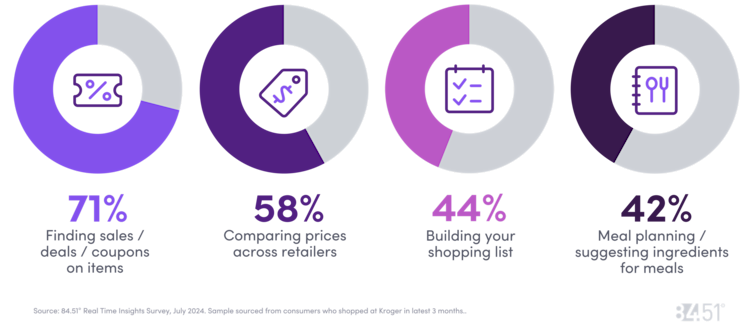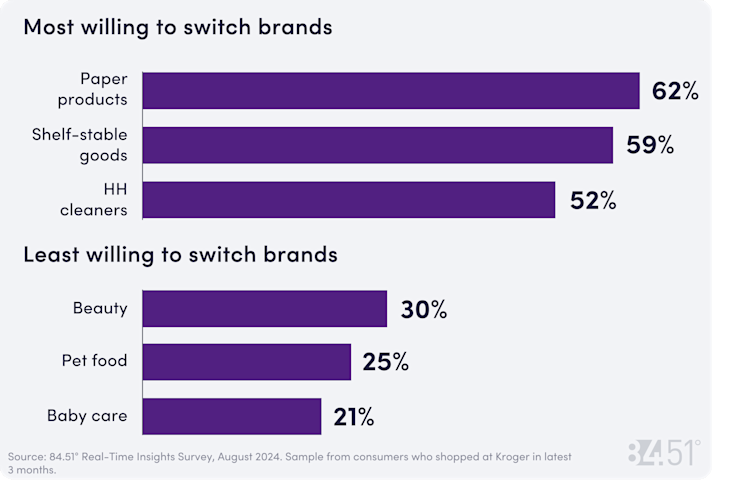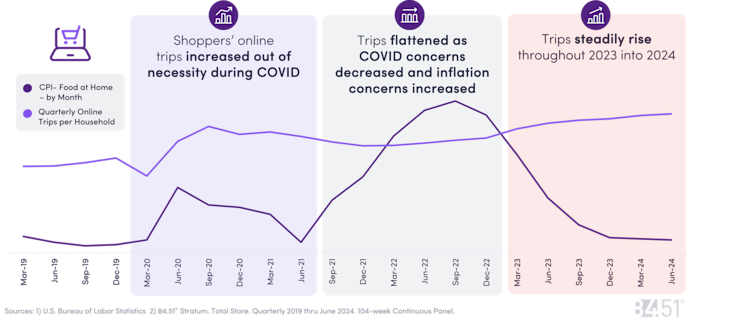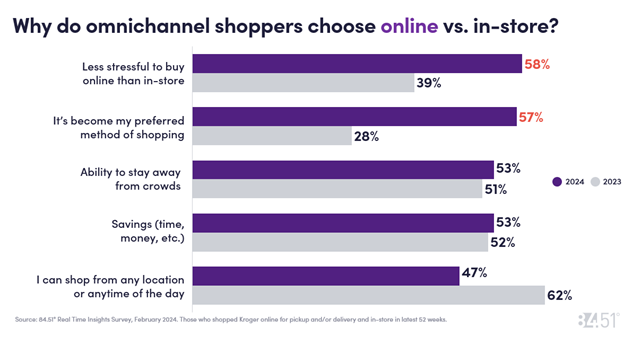
3 key factors shaping consumer behavior and brand success

Brands today are facing a fundamental shift in consumer behavior that is driven by a confluence of factors. These factors—hyperconnectivity, inflation and omnichannel shopping—are reshaping how consumers make decisions, shifting their mindset toward value and eroding traditional brand loyalty. At a recent conference, Cara Pratt, SVP, Kroger Precision Marketing at 84.51°, outlined these challenges and discussed what brands can do to thrive in this evolving landscape.
Hyperconnectivity
One of the most significant factors influencing consumer behavior is hyperconnectivity. The always-on nature of digital access has “accelerated the flow of information,” Pratt noted, giving consumers real-time control over their shopping experience. From instant price comparisons to reviews and product availability, hyperconnectivity has shifted power toward the consumer.
In a hyperconnected world fueled by technology, consumers have come to expect convenience, consistency and a personalized experience across all touchpoints. Hyperconnectivity, Pratt continued, is also “enabling us, as brand builders, to create connectivity in special ways that matter, resonate and retain the essence of the brand in the consumer’s mind.”
Brands, for instance, can now take a more layered and sophisticated approach to personalization. “There are degrees of personalization,” Pratt said, noting that it’s no longer just about personalized offers but also about creating personalized content and experiences that resonate with consumers on a deeper level.
Inflation: reinforcing the value-driven mindset
While hyperconnectivity empowers consumers with information, inflation is driving them to be more price-sensitive and value-conscious. Even as inflation rates stabilize, the perception of inflation remains high, influencing consumer behavior.
Indeed, our research shows that shoppers are looking for features that help them save time and money.
This value-driven mindset is particularly noticeable in categories where consumers are more likely to trade down to cheaper options or private labels, such as for paper products, shelf-stable goods and household cleaners (see chart below). As Pratt noted, “consumers are shifting their mindset on brand loyalty, and we’re seeing more trade-downs happening.”
In this environment, brands have an ongoing opportunity to highlight their value propositions; those that demonstrate they understand consumers' financial pressures can win their trust.
Omnichannel shopping
Another key factor impacting loyalty is the rise of omnichannel shopping. An analysis of online shopping trips shows that online shopping has normalized as consumers increasingly rely on digital platforms for their needs.
As Pratt noted, “the future of shopping is omni” and brands need to “think about the experience that is being built online, just as much as [the] in-store environment.”
As shoppers blend online and in-store shopping, the opportunity to discover new brands increases. While increased exposure is a boon for brands, it also fragments loyalty, as shoppers are more easily exposed to alternative brands and deals.
This creates both a challenge and opportunity: increased customer engagement across more channels in addition to a greater chance of brand switching as customers search for a better offer or more convenience. An answer to this conundrum could be to understand what drives consumers to shop in-store versus online and vice versa.
Understanding the motivations behind omnichannel shoppers' preferences can help address the challenge of increased brand switching in several ways. As demonstrated in the chart below, our research shows that shoppers increasingly view online shopping as their preferred method (57%), appreciating the convenience of shopping from any location (47%).
However, both online and in-store experiences offer unique benefits. While online shopping provides the ability to avoid crowds (53%), in-store experiences offer irreplaceable advantages such as immediate product access and in-person service.
By recognizing these diverse preferences, brands in collaboration with retailers can create complementary experiences across both channels. They can enhance their digital platforms with user-friendly interfaces and personalized recommendations, while also focusing on creating inviting, stress-free in-store environments with knowledgeable staff. This balanced approach can foster brand and retailer loyalty across all touchpoints, potentially reducing the likelihood of customers switching to competitors when exposed to more options in the omnichannel environment.
The erosion of loyalty is an organization-wide challenge
The key takeaway is that as these factors—hyperconnectivity, inflation and omnichannel shopping—shape consumer behavior, brands are facing an erosion of loyalty that demands a more comprehensive approach. It is not enough to rely on individual departments to create standout consumer experiences.
“This isn't just the CX team's job to shape the experience you want to curate across every retailer,” Pratt said. “This isn't the marketing team's job to make sure you've got beautiful content. If you can't manufacture the product, move it through your supply chain, and have your sales team sell it, it's not going to matter.”
In this hyperconnected world, every part of the business—from product development to supply chain, sales and marketing—must work together to create a seamless, value-driven experience that keeps consumers engaged, she noted.
Siloed efforts will not be enough to combat the erosion of loyalty brought on by these factors. Brands that want to win must foster cross-functional collaboration and alignment to meet consumer expectations across all fronts. As Pratt put it, "it’s everybody’s job to create this environment, to win in this hyperconnected world."
Visit our knowledge hub
See what you can learn from our latest posts.





